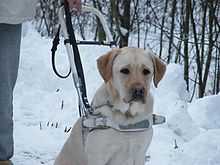Mobility assistance dog



A mobility assistance dog is a service dog trained to assist a physically disabled person who has mobility issues, which may include being wheelchair-dependent. Among other tasks such as "providing balance and stability"[1] and "pulling wheelchairs or carrying and picking up things for persons with mobility impairments",[2] a mobility assistance dog can be trained to open and close doors, and operate light switches, and can "have a major positive impact on the lives of recipients".[3]
Some larger-statured dogs with sound joints are trained to pull individuals in wheelchairs, and wear a type of harness specifically designed for pulling.[2] However, wheelchair pulling remains controversial, and is illegal in England.[4] Many US programs limit "wheelchair pulling" to short straight distances, most commonly for assistance getting in and out of a crosswalk. One study has found that using the traction provided by the service dog has physical benefits because manual wheelchair users can operate their chairs with less effort[5]
Another type of mobility assistance dog task is that of a "walker dog". They are used for Parkinson's Disease and multiple sclerosis patients, along with other disorders and conditions. These dogs are not canes, and the handler does not put full weight on them. However, the dog can greatly assist a person with their gait and balance while walking. This technique is usually called "counterbalance".[6] It can also be helpful for those with the symptom of proprioception, the inability to walk in a straight line.
As with other types of assistance dogs, in many countries disabled individuals have the right to bring their mobility assistance dogs with them into places where animals are generally not allowed, such as public transportation, restaurants, and hotels. In the United States, the Americans with Disabilities Act is the law guaranteeing this opportunity to disabled individuals for public access situations. If access is denied to a disabled individual, federal and some state laws have penalties that may be brought against the business denying access.[7]
In the UK, the dogs are called disability assistance dogs are often trained and supported by charitable organizations.[8]
Assistance Dogs International (ADI) "is a coalition of not for profit organizations that train and place assistance dogs."[9] They publish a Guide to Assistance Dog Laws which summarizes the federal and state-by-state laws pertaining to service dogs.[10]
References
- ↑ "Service/Assistance Animals", New Hampshire Governor's Commission on Disability.
- ↑ 2.0 2.1 "Commonly Asked Questions about Service Animals in Places of Business", U.S. Department of Justice, Civil Rights Division.
- ↑ "Effects of Assistance Dogs on Persons with Mobility or Hearing Impairments: A Pilot Study", Journal of Rehabilitation Research & Development".
- ↑ "Information for Visitors Bringing an Assistance Dog to the London Olympics 2012", Assistance Dogs UK.
- ↑ "Effect of Service Dogs on Manual Wheelchair Users with Spinal Cord Injury: A Pilot Study", Journal of Rehabilitation Research & Development".
- ↑ "Assistance Dogs Transform Lives of Veteran Partners", U.S. Department of Veterans Affairs.
- ↑ "Revised ADA Requirements: Service Animals", U.S. Department of Justice, Civil Rights Division.
- ↑ "Assistance and Guide Dogs", NIDirect.
- ↑ Assistance Dogs International website
- ↑ "Guide to Assistance Dog Laws", Assistance Dogs International.